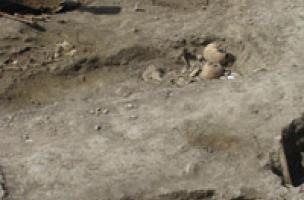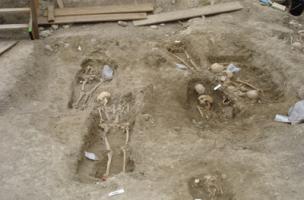This preventive excavation, curated by the Regional Archaeology Service, is on the site of a nursing home to be built by the Sogea Construction Company. This is the first Protestant cemetery in France to be excavated. Until now, only isolated graves were known so the research implications are considerable. After the proclamation of the Edict of Nantes, Parisian Huguenots were buried there (from 1606 to 1685), near the well-known church of Charenton-le-Pont (now in the commune of Saint-Maurice).
This was the place of worship of the Parisian Huguenots and of all other European Protestants who passed through Paris at that time. Archaeologists expect to excavate many skeletons which when studied, by physical anthropologists, will provide new information concerning mortuary rites, adding to what is known from written sources.
Protestants and death
It is doubtless in their attitude towards death that Catholics and Protestants differ most during the 16th and 17th centuries. Protestant doctrine rejects the idea of Purgatory, the worth of masses for the dead, the worship of saints, the veneration of relics. . . John Calvin advocated "honest" funerals, that is, decent, without practices considered as superstitious: no tombstone, no preaching in the cemetery, no offerings . . . Inevitably this brought about a split with the Catholics who practised a cult of the dead and considered cemeteries as sacred places. The Wars of Religion were rich in sectarian violence, profanations and exhumations taking place in both camps . . .
The Edict of Nantes
In 1598, the Edict of Nantes established the coexistence of the two communities with the restitution of places of worship and the separation of cemeteries. In order to avoid another Saint Bartholomew's night massacre, Parisian Protestants were required to worship at a distance of five leagues from the city, in the church of Charenton-le-Pont. In addition, a royal decree of 1609 declared that burials should take place at night, without funeral processions, and under the guard of an archer of the watch - in order to avoid any disorder or riots.
What were in fact the funerary practices?
The austerity of Protestant religious practices and the conditions imposed on burials may have had important consequences on burial practice. For all that, in Europe, rich Protestants preferred more elaborate funerals than those authorised by dogma. In the 17
th century, in the whole of the Christian western world, the fashion was to bury in lead coffins. Did the Parisian Huguenots ignore this fashion? In Béarn, Protestant soldiers wanted to maintain traditional pomp during their military funerals. In Scotland and the Netherlands, burials continued to take place in churches. Everywhere, the desire to be buried with one's (Catholic) ancestors remained strong.
Historians believe that Protestants experienced, at that time, difficulties in breaking away from medieval funeral practices. In European countries where modern Protestant cemeteries have been excavated, it is difficult to see the difference between a Catholic and a Protestant burial. It will thus be interesting to see what archaeologists will find at Saint-Maurice.
Site Director : Jean-Yves Dufour, Inrap.
Curation : Regional Archaeological Service (Drac Île-de-France)
Developers : Sogea Construction




